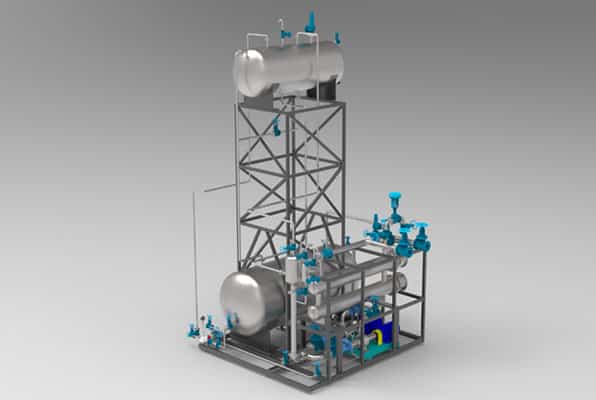In industrial processes, electric thermal oil heaters https://8ruiyan.com/en/all-organic-heat-carrier-boilers/ are the “heart” of many operations due to their even heating and precise temperature control. However, if not properly maintained, the high-temperature, high-pressure oil inside can be like “lava” waiting to erupt.Oil spray accidents can have disastrous consequences—equipment destruction, production shutdowns, fires, and even explosions, posing a severe threat to lives.
These accidents are not random. They are usually the result of multiple safety failures. This article explores how to build strong defenses to reduce the risk of an oil spray accident to zero.

1. Know the Enemy: Common Causes of Oil Spray Accidents
Understanding the problem is the first step to prevention. Key causes include:
- Water Intrusion and Instant Vaporization (Most Common & Dangerous!): If water is present in the system or new oil, it instantly turns to steam upon entering the hot heater. This steam expands violently, increasing pressure dramatically and forcing a mixture of hot oil and vapor out through flanges or valves.
- Pipe Blockages and Trapped Pressure: A frozen or blocked expansion tank connection line, or a clogged filter, can prevent the system from safely releasing excess pressure. This pressure will eventually find the weakest point to escape.
- Temperature Runaway and Oil Degradation: Heating the oil beyond its maximum rated temperature causes it to break down (crack). This forms carbon and sludge, which can clog pipes, corrode equipment, and reduce efficiency. This creates a dangerous cycle leading to overheating and overpressure.
- Welding Defects and Material Fatigue: Weak welds (with pinholes or cracks) or general aging of equipment from long-term exposure to high heat can lead to sudden ruptures under pressure.
- Operator Error: Examples include failing to purge air before start-up, heating the oil too quickly from a cold state, or closing the wrong valve.
2. A Systematic Prevention Plan
Preventing accidents requires a systematic approach covering design, operation, and maintenance.
Defense 1: Proper Design & Installation
- Correct Sizing & Design: Ensure the expansion tank is installed high enough and has sufficient capacity. Its bottom should be at least 1.5 meters above the system’s highest point. Never install a valve on the expansion tank connection pipe!
- Quality Materials: Use approved pipes, valves, and gaskets. Flange gaskets must be high-temperature, oil-resistant metal ring gaskets. Avoid standard materials.
- Professional Welding: All piping must be welded by certified professionals. Welds should be inspected for defects.
Defense 2: Safe Operation is Key
- Purging Air and Removing Water
- After installation or major maintenance: This is the most critical phase. Follow a two-step process: “low-temperature dehydration” followed by “high-temperature purging of light components.”
- Low-Temperature Dehydration: Start the circulation pump. Then, heat the oil slowly—no faster than 20°C per hour—to 95-110°C. Hold this temperature until the pressure stabilizes and only oil vapor (no white steam) comes from the vent.
- Gradual Heating: After dehydration, continue heating at 20-40°C per hour until you reach the working temperature. Never set a high temperature directly from a cold start!
- Watch Temperature & Pressure
- Temperature Control: Strictly maintain the outlet temperature below the oil’s maximum limit.
- Pressure Monitoring: Watch for abnormal pressure fluctuations. Ensure pressure gauges and level indicators work correctly.
- Expansion Tank Level: Check the level regularly. A level that is too high or too low can indicate a problem.
Defense 3: Routine Maintenance & Inspection
- تحليل الزيت العادي: Take a sample of the thermal oil at least once a year for laboratory analysis. Check key indicators like viscosity, acidity, flash point, and carbon content. Replace or top off the oil as needed.
- System Cleaning: Based on oil analysis and performance, clean the entire system every 1-3 years to remove carbon deposits and sludge from the pipes.
3. The Last Line of Defense: Reliable Safety Devices
Safety devices are your final protection. Keep them fully reliable:
- Safety Valves: Test and calibrate safety valves at least once a year. Ensure they open and close at the correct pressures.
- Rupture Discs: These are used where safety valves aren’t suitable. Replace them periodically as recommended.
- Differential Pressure Alarms: Install alarms on filters to signal when cleaning is needed, preventing blockages.
- Automatic Shutdown Systems: Regularly test all interlock systems (for level, temperature, pressure) to ensure they function correctly.
الخاتمة
There is no shortcut to preventing oil spray accidents in electric thermal oil heaters. Safety depends on solid design, strict procedures, consistent maintenance, and a strong safety culture.
Every operator and manager must remember: Safety rules are not restrictions; they are the iron-clad laws that protect lives and assets.
Share this guide with your team. Let’s work together to ensure these industrial “hearts” operate safely, reliably, and efficiently.
For further consultation, please contact our technical team for expert advice.
Whatsapp:86-19106101570
wechat:86-19106101570
email:fob@jsryan.com
